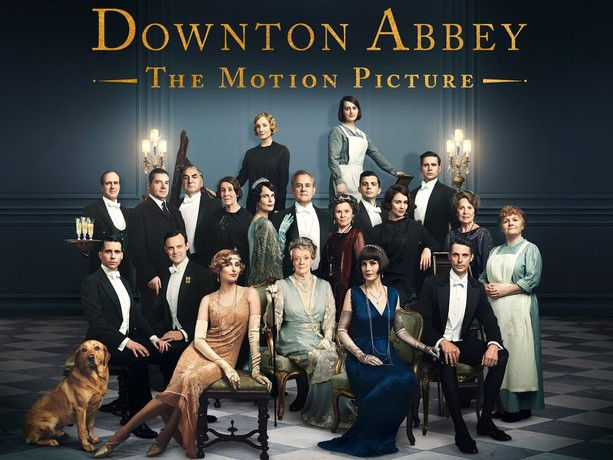A Revisit of the Beloved “Downton Abbey” Films
- Matt Palmer
- Sep 15
- 4 min read

“Downton Abbey: The Grand Finale” is now showing on the big screen and since I haven’t seen the previous two films since I initially reviewed them for the Examiner, it was time for another look.
In the 2019 film adaptation, the beloved Crawleys and their intrepid staff prepare for the most important moment of their lives. A royal visit from the king and queen of England soon unleashes scandal, romance and intrigue - leaving the future of Downton hanging in the balance.
“Downton Abbey: The Movie” has been really well received by fans of the series during its initial theatrical run. The 2019 film features beautiful costumes and scenery, compelling moments from your favorite characters and some witty humor, along with a scene-stealing Maggie Smith (R.I.P).
In this film adaptation, we get to see the characters and how their relationships continue to develop and, of course, more witty moments from Violet and Isobel. Fans and critics have agreed that this film seemed like an extended episode of the beloved series and they were completely fine with it.
My favorite moment of this film is when the Downton staff begin plotting to send the royal staff home which leads to quite a few humorous moments. And the final celebration, where we see the entire Crawley family dancing and celebrating is a great way to wrap up this follow-up.
MPA: Rated PG for thematic elements, some suggestive material, and language (runtime 122 minutes).
Moving on to the 2022 sequel “Downton Abbey: A New Era,” the Crawley family goes on a grand journey to the South of France to uncover the mystery of the dowager countess’ newly inherited villa.
Just like the original series and the beloved 2019 film, “Downton Abbey: A New Era” is well liked by general audiences and fans of the series. The 2022 follow-up is another faithful continuation of both the series and the previous film, while also having an interesting dual plot - a Crawley family adventure to South France and a film crew at Downton. Also, quick side note, some of the South of France scenery is simply amazing.
“A New Era” delivers quite an intriguing story as we learn some secrets about a few characters, which includes Lord Grantham’s realization about his father’s past love. This follow-up also delivers an emotional journey for the characters, including an emotional passing of the beloved Dowager Countess of Grantham (Violet Crawley, portrayed for the last time by the late great Maggie Smith).
The “Downton Abbey” films received a largely positive overall response from fans of the original series, who appreciated the lavish escapism and comfortable continuation of familiar characters and settings.
MPA: Rated PG for some suggestive references, language and thematic elements (runtime 122 minutes).
You can currently stream both the “Downton Abbey” films and the original series on the Peacock streaming service and make sure to catch my review of “Downton Abbey: The Grand Finale” in the Sept. 24 edition!
The royal visit of King George V to Downton Abbey was based on his real-life visit to Wentworth Woodhouse, a mansion in Yorkshire which was used in this movie for the ballroom scenes at Harewood House.
Dame Imelda Staunton (Lady Bagshaw) is the real-life wife of Jim Carter (Mr. Carson).
The mansion that King George V and Queen Mary visit after Downton Abbey, where the ball is held at the end of this movie, is Harewood House. Although the name of the village is pronounced as it is spelled (Hare-wood), the House and the title Lord Harewood are perversely pronounced Harwood, as was correctly done throughout this movie.
King George V alludes to the General Strike of 1926, which effectively shut down the country for nine days after an alliance of unions that included railway and transport workers, miners, utility workers, and printers went on strike.
The visitors, King George V and Queen Mary (previously Princess Mary of Teck), were the grandparents of Queen Elizabeth II.
The fact that the movie that was made at Downton helped to fund a new roof is based on real life. The real Highclere Castle was not in good shape, but because of Downton Abbey (2010) being shot at it, the owners were able to fund a new roof.
The location used for Tom and Lucy's wedding is Belchamp Hall in Essex, with the adjacent church of St Mary the Virgin, Belchamp Walter hosting the ceremony. The bells heard as they leave the church are not the bells in the tower and were dubbed on for the soundtrack, as the church's eight bells (dating between 1712 and 1891) are unsafe to ring as of 2022.
Even in scenes set before going to the south of France, Robert and Carson look very tan. The reason for that was that the scenes set in France were filmed before the scenes set at Downton. Because of the Covid-19 Pandemic the group that filmed in the South of France had to quarantine for two weeks before shooting. Hugh Bonneville, Allen Leech, and Jim Carter were encouraged to get outside and get some sun.
Director Simon Curtis is married to Elizabeth McGovern, who plays Cora Crawley.
The Dowager Countess's line "the worst excesses of the French Revolution" is taken directly from Lady Bracknell in Oscar Wilde's play "The Importance of Being Earnest". In 1993, Maggie Smith played this role at the Aldwych Theatre in the West End, receiving her fourth Olivier Award nomination.







Comments